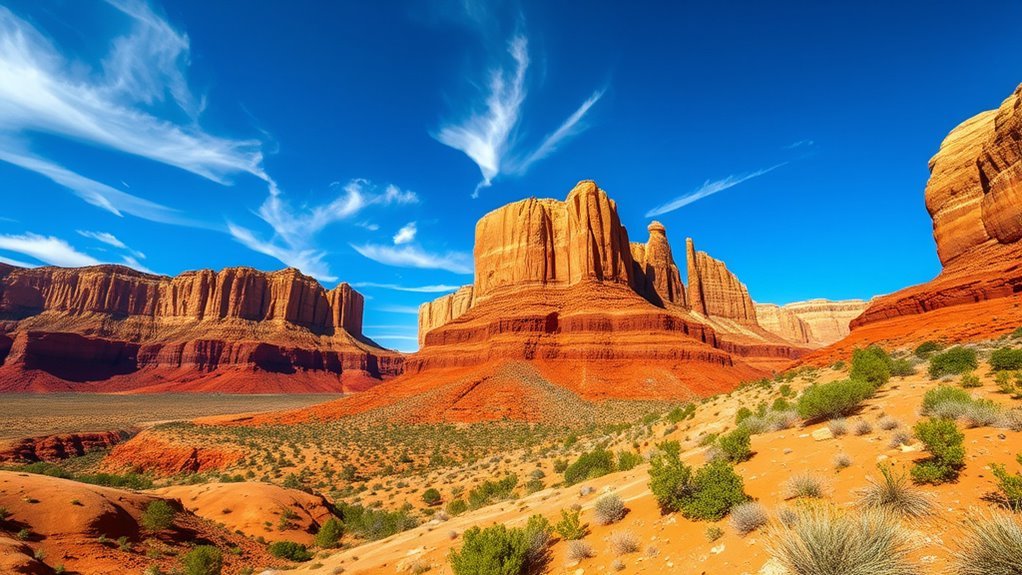When you explore Capitol Reef National Park, you’ll encounter a remarkable blend of natural beauty and history. Located in southern Utah, this park features stunning geological formations, such as the Waterpocket Fold, and evidence of ancient civilizations. As you hike its trails and witness its diverse ecosystems, you’ll uncover the stories etched in the landscape. With its Gold Tier Dark Sky designation, the park offers more than just daytime adventures. Curious about what else awaits?
Key Takeaways
- Capitol Reef National Park is located in southern Utah, covering 241,904 acres and features the Waterpocket Fold, a significant geological monocline.
- It is renowned for its stunning landscapes, including canyons, cliffs, and arches, which have been shaped by millions of years of geological processes.
- The park is the least visited of Utah’s national parks, offering a serene escape with opportunities for hiking, stargazing, and exploring historic sites.
- Over 840 plant species and 300 wildlife species, including rare and endemic species, inhabit the park’s unique ecosystems.
- The visitor center offers essential information, along with nearby accommodations and attractions, including Bryce Canyon and Canyonlands National Parks.
Overview of Capitol Reef National Park
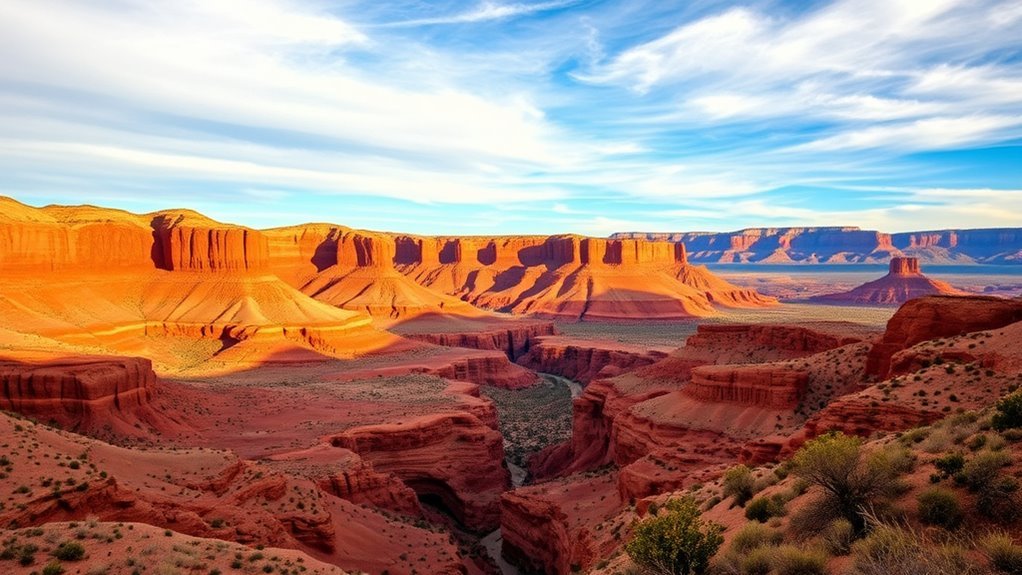
Nestled in southern Utah, Capitol Reef National Park offers an expansive 241,904-acre wonderland that captivates with the Waterpocket Fold, North America’s largest exposed monocline.
This park, one of Utah’s hidden gems, invites you to explore its stunning landscapes, including canyons, cliffs, and arches. As the least visited of Utah’s five national parks, it provides a serene escape for those seeking adventure in hiking and backpacking.
Start your journey at the visitor center, where you can learn about the park’s unique geological formations and plan your route through its diverse trails.
Despite its relative obscurity, Capitol Reef’s 4.7-star rating and the Travelers’ Choice award for 2024 highlight its appeal to outdoor enthusiasts.
Geography and Geology of Capitol Reef
You’ll find Capitol Reef’s landscape dominated by the Waterpocket Fold, a striking monocline that stretches for about 100 miles.
As you explore, notice the layers of sandstone and other formations laid down approximately 65 million years ago, which bear witness to the park’s ancient marine history.
These geological marvels, formed by events such as the Laramide orogeny and subsequent erosion, create an enchanting tapestry of cliffs, domes, and canyons.
Waterpocket Fold Formation
As you explore the fascinating landscape of Capitol Reef National Park, the Waterpocket Fold stands out as a remarkable proof of the Earth’s dynamic history.
This unique geological formation spans approximately 100 miles, showcasing the intricate artistry of nature—the fold formed during the Laramide Orogeny, reactivating an ancient fault. Over millions of years, erosion has sculpted the landscape into a stunning array of colorful cliffs and geological formations.
Here, you’ll encounter:
- Navajo Sandstone: Its vibrant hues and smooth texture reflect the park’s ancient desert environment.
- Twisting Canyons: Carved by relentless water, they reveal layers of sedimentary rocks.
- Massive Domes: These majestic structures rise dramatically, shaped by the forces of erosion.
These features illustrate the park’s ongoing geological evolution.
Geological Time Layers
When you explore the geological time layers of Capitol Reef National Park, you uncover a rich tapestry of Earth’s history.
The park’s centerpiece, the Waterpocket Fold, stretches 100 miles and reveals layers formed 50 to 70 million years ago. This geological formation showcases a fascinating stratigraphic history, featuring the Navajo Sandstone‘s whitish cliffs.
These cliffs, dating back 190 million years, were once ancient desert dunes. Over the past 15 to 20 million years, erosion has sculpted the park’s colorful cliffs, domes, and canyons, exposing its diverse features.
Tectonic activity reactivated ancient faults, shaping formations like the Cutler and Morrison Formations. As you wander, these layers tell stories of shifting landscapes and Earth’s dynamic past, etched in stone.
Ancient Marine History
Capitol Reef’s ancient marine history is etched in its dramatic landscapes and rock formations. Once at the edge of a shallow sea during the Middle to Late Triassic period, Capitol Reef’s geology tells a story of sediment deposition and tectonic activity.
The imposing Waterpocket Fold is a testament to these ancient forces, showcasing a 100-mile-long monocline that formed 50 to 70 million years ago. As you explore, you’ll see:
- Colorful Cliffs: Erosion has sculpted vibrant cliffs, exposing layers of history.
- Massive Domes: These formations reveal the park’s dynamic geological processes.
- Twisting Canyons: Carved by erosion over millions of years, they reflect nature’s artistry.
Each feature is a vivid reminder of the ancient marine influences that shaped this incredible landscape.
History and Cultural Significance
Though Capitol Reef National Park‘s striking landscapes draw visitors today, its roots run deep into history and cultural significance. The area, once home to the Fremont culture around 1000 AD, showcases their impressive rock art and granaries.
By the 13th century, these settlements were abandoned, likely due to drought. Later, Mormon pioneers in the 1880s established communities and planted orchards, remnants of which you can still explore.
Recognizing its cultural heritage, President Franklin D. Roosevelt designated it as a national monument in 1937. Don’t miss the area’s historical touch with uranium mining, which began in the early 20th century.
Finally, in 1971, President Nixon officially designated it as Capitol Reef National Park, thereby preserving its unique history and landscape.
Flora and Fauna in Capitol Reef
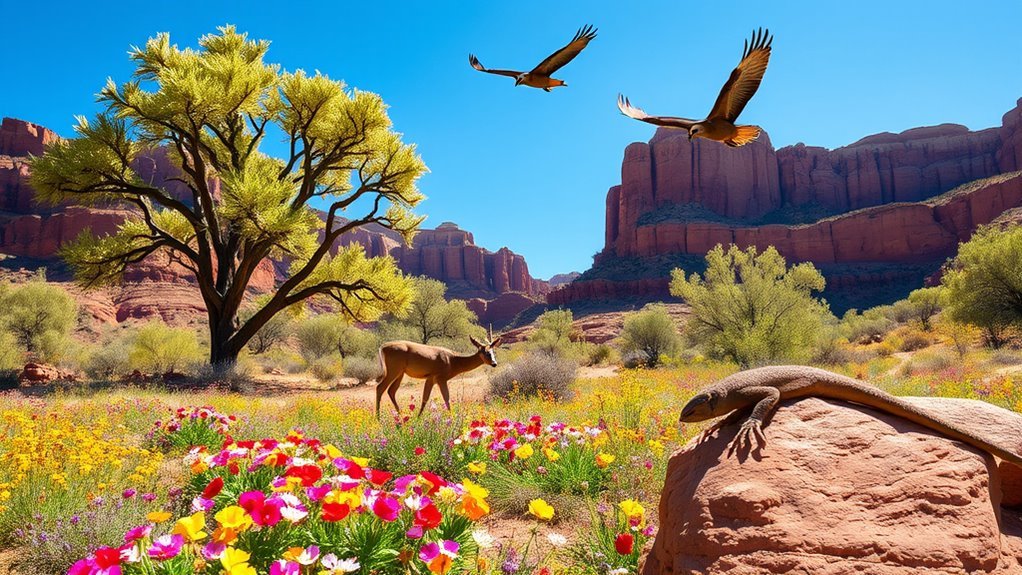
As you explore Capitol Reef, you’ll encounter over 840 plant species, including more than 40 rare and endemic species to the area.
These diverse plant communities thrive in the unique habitats shaped by the Waterpocket Fold.
Keep an eye out for these remarkable species that define the park’s vibrant ecosystem.
Rare and Endemic Species
With its breathtaking landscapes and diverse ecosystems, Capitol Reef National Park is a haven for rare and endemic species, showcasing the park’s rich biodiversity.
You’ll discover over 40 rare plant species, including the Capitol Reef monkeyflower and Glenwood springflower, each with its unique habitat needs. The park’s ecosystems also support over 300 wildlife species, providing critical habitats for the Utah prairie dog, a species of concern.
Immerse yourself in the park’s natural wonders as you:
- Observe the unique flora thriving in the Waterpocket Fold’s diverse habitats.
- Spot majestic golden eagles soaring above, alongside ravens and deer.
- Witness conservation efforts protecting these unique species, ensuring their survival for future generations.
Capitol Reef’s dedication to conservation preserves its ecological integrity.
Diverse Plant Communities
Exploring Capitol Reef National Park, you’ll find a rich tapestry of plant communities thriving in its unique landscapes. The park’s diverse habitats, shaped by the Waterpocket Fold, support over 840 species of plants. You’ll discover ecosystems ranging from high desert to riparian zones, each harboring distinct flora. Rare species, more than 40, add to the park’s botanical charm. The piñon pine, juniper, and sagebrush dominate the high desert areas, while wildflowers burst into vibrant colors during spring and summer.
Capitol Reef’s historic orchards, originally planted by Mormon pioneers, still flourish today. These orchards feature fruit trees, allowing you to pick cherries, apricots, and more during harvest season.
| Habitat Type | Notable Feature |
|---|---|
| High Desert | Piñon pine, sagebrush |
| Riparian Zones | Rare species |
| Orchards | Fruit trees |
Activities and Exploration Opportunities
When you visit Capitol Reef National Park, you’re stepping into a world filled with diverse activities and exploration opportunities. Imagine:
- Marveling at geological wonders: Set out on the Hickman Bridge and Cassidy Arch trails, where natural arches and towering formations await your discovery.
- Engaging with nature: Join ranger-led programs to learn about the park’s unique ecosystem or pick your fruit from historic orchards filled with ripe cherries and apples.
- Experience breathtaking views by taking the Scenic Drive along the Cathedral Valley Loop, which offers stunning vistas of the park’s rugged terrain.
As the sun sets, gaze at the stars in this Gold Tier Dark Sky Park, where the night sky becomes a canvas of twinkling constellations.
Capitol Reef offers something for everyone.
Hiking Trails in Capitol Reef
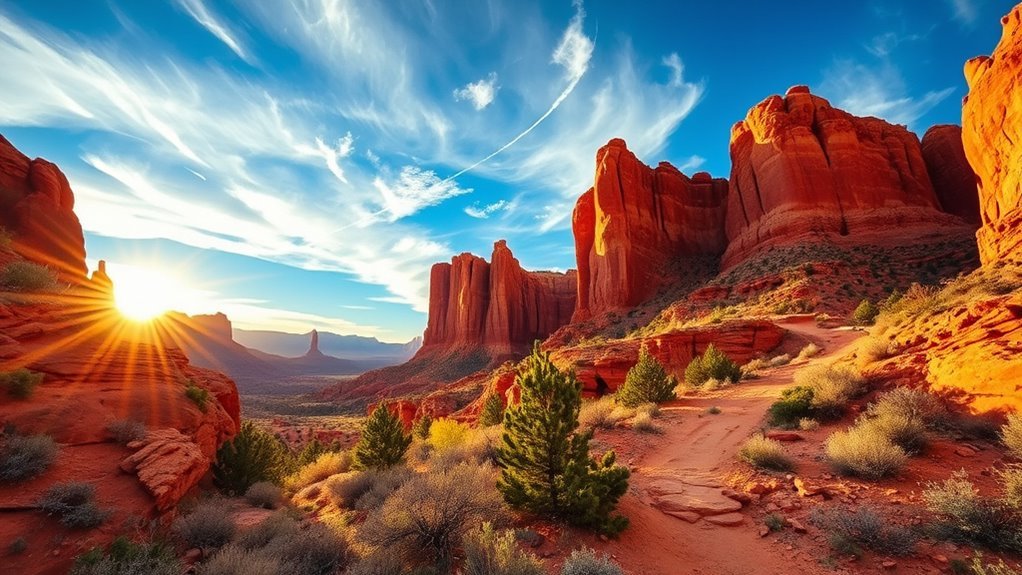
If you’re seeking an unforgettable hiking experience, Capitol Reef National Park’s trails won’t disappoint. Begin with the Cassidy Arch Trail, a steep and strenuous 3.5-mile round-trip route that offers breathtaking views. The Hickman Bridge Trail, at 2 miles, requires moderate effort and rewards you with a natural bridge and ancient ruins. For a longer adventure, consider the Grand Wash, but arrive early to secure a parking spot.
| Trail | Highlights |
|---|---|
| Cassidy Arch Trail | Scenic views, challenging hike |
| Hickman Bridge Trail | Natural bridge, ruins |
| Capitol Gorge | Petroglyphs, flash flood risk |
Be cautious of flash floods, especially in Capitol Gorge’s narrow canyons. Many trails offer glimpses of petroglyphs, adding a cultural touch to your journey. Plan early morning hikes to avoid the intense summer heat.
Stargazing and Dark Sky Designation
After a day of exploring Capitol Reef’s enchanting trails, look up for an entirely different adventure under the night sky.
Designated as a Gold Tier Dark Sky Park in April 2015, Capitol Reef offers you a spectacular stargazing experience with minimal light pollution. Here, you’ll find some of the darkest night skies in the United States, perfect for witnessing the Milky Way and other celestial phenomena.
Imagine:
- The Milky Way stretches across the vast sky, a river of stars.
- Celestial events, such as meteor showers, dazzle above.
- Endless constellations twinkling in their eternal dance.
Organized stargazing events offer the opportunity to learn about astronomy and the preservation of dark skies.
The park’s remote location and elevation make it a paradise for astronomers.
Visiting and Travel Information
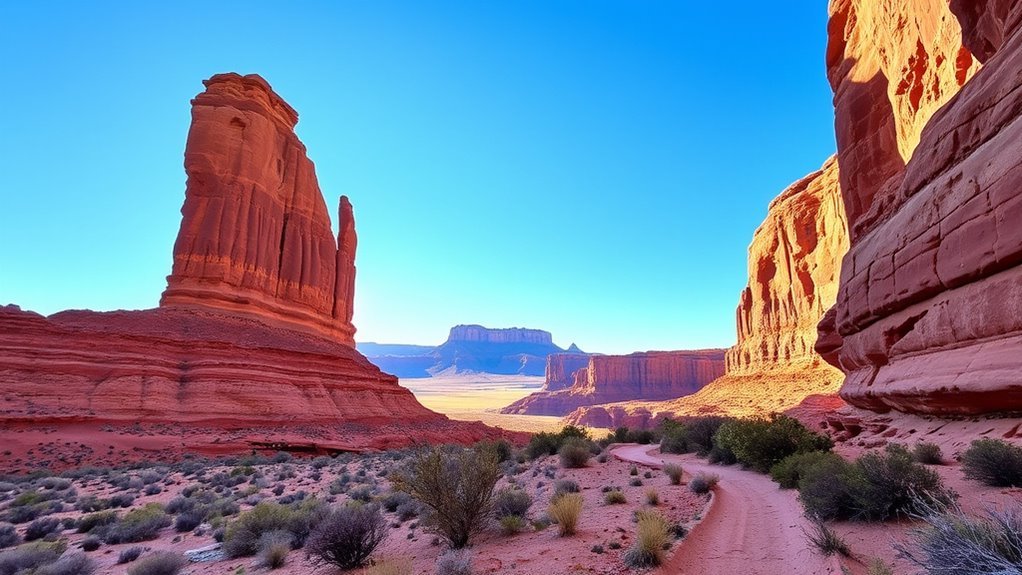
How do you make the most of your visit to Capitol Reef National Park? Start by exploring the scenic beauty of Southern Utah.
The park’s visitor center, open year-round from 8:00 a.m. to 4:30 p.m. (and until 6:00 p.m. in summer), offers essential information. Begin your adventure with a hike to iconic spots, but arrive early to secure a parking spot.
Don’t miss the historic Fruita Schoolhouse and try fruit picking in the orchards, which are usually open from March to October.
After a day of exploring, head to the nearby town of Torrey, just 11 miles away, for dining options.
Whether you’re sightseeing or auto touring, check road conditions ahead of time to ensure a safe and enjoyable Capitol Reef experience.
Nearby Attractions and Accommodations
Once you’ve soaked in the beauty of Capitol Reef National Park, it’s time to explore the nearby attractions and accommodations that enhance your visit.
Just 11 miles from the visitor center, Torrey offers cozy motels and delightful dining options. For a more immersive experience, consider staying at the Capitol Reef Resort, only a mile from the park entrance, or the charming Broken Spur Inn.
You’ll find nearby attractions, such as Bryce Canyon and Canyonlands National Parks, perfect for day trips.
Don’t miss the park’s historic fruit orchards, where you can:
- Pick seasonal fruit from trees planted by Mormon pioneers.
- Enjoy a taste of history with homemade jams.
- Savor delicious pies in the quaint towns of Teasdale and Bicknell.
Conclusion
When you visit Capitol Reef National Park, you’re stepping into a world where ancient history and natural beauty collide. You’ll marvel at the unique geology, explore trails that showcase the park’s vibrant flora and fauna, and lose yourself under the star-filled skies. Whether you’re hiking, stargazing, or immersing yourself in the rich cultural history, Capitol Reef offers a truly memorable experience. Plan your trip, pack your bags, and get ready for an unforgettable adventure.
FAQs
1. Are There Any Guided Tours Available in Capitol Reef National Park?
You’re curious about guided tours, aren’t you? Yes, they’re available. You’ll find various options, from ranger-led hikes to private group tours. It’s a great way to explore and learn more about the area’s unique features.
2. What Is the Best Time of Year to Visit Capitol Reef?
You should visit in spring or fall when the weather’s mild, and crowds are smaller. You’ll enjoy pleasant hiking conditions and stunning scenery. Summer can be hot, while winter might bring closures due to snow.
3. Are Pets Allowed in Capitol Reef National Park?
You are welcome to bring pets, but please keep them on a leash at all times. You’re allowed to take them on certain trails and in the developed areas. Don’t forget to clean up after them and guarantee their safety at all times.
4. Can I Camp Overnight in Capitol Reef National Park?
Yes, you can camp overnight. Be sure to reserve a spot in advance, as campgrounds can fill up quickly. Follow park regulations to ensure a safe and enjoyable experience. Don’t forget to pack all necessary gear.
5. Is There an Entrance Fee to Capitol Reef National Park?
Yes, you’ll need to pay an entrance fee. However, if you hold an annual national parks pass, you won’t have to pay. It’s always a good idea to check the latest fee schedule before visiting.
